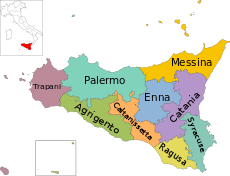Kingdom of Sicily
| Kingdom of Sicily Regnum Siciliae (Latin) Regnu di Sicilia (Sicilian) Regno di Sicilia (Italian) | ||||||
| Personal unions with:
the Holy Roman Empire (1220–1250) the Crown of Aragon (1282–1516) the Kingdom of Spain (1516–1713) the Duchy of Savoy (1713–1720) the Habsburg Monarchy (1720–1735) the Kingdom of Naples (1735–1816) | ||||||
| ||||||
| ||||||
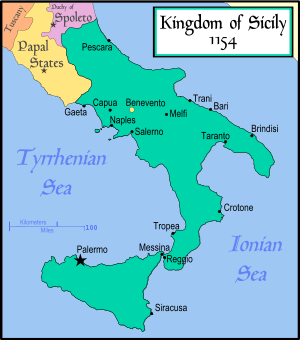 | ||||||
| Capital |
| |||||
| Government | Feudal monarchy | |||||
| King | ||||||
| • | 1130-1154 | Roger II | ||||
| • | 1266-1282 | Charles I of Anjou | ||||
| • | 1759-1816 | Ferdinand III | ||||
| History | ||||||
| • | Coronation of Roger | 1130 | ||||
| • | Sicilian Vespers | 1282 | ||||
| • | Two Sicilies | 1816 | ||||
| Today part of | | |||||
The Kingdom of Sicily (Latin: Regnum Siciliae, Italian: Regno di Sicilia, Sicilian: Regnu di Sicilia,[1][2][3][4] Catalan: Regne de Sicília, Spanish: Reino de Sicilia) was a state that existed in the south of the Apennine peninsula from its founding by Roger II in 1130 until 1816. It was a successor state of the County of Sicily, which had been founded in 1071 during the Norman conquest of the southern peninsula. Until 1282 the Kingdom (sometimes called the regnum Apuliae et Siciliae, "Kingdom of Apulia and Sicily") covered not only the island of Sicily, but also the whole Mezzogiorno region of the southern Apennines and the Maltese archipelago. The island was divided into three regions: Val di Mazara, Val Demone and Val di Noto; 'val' being the Arabic word meaning 'district'.
In 1282, a revolt against Angevin rule, known as the Sicilian Vespers, threw off Charles of Anjou's rule of the island of Sicily. The Angevins managed to maintain control in the mainland part of the kingdom, which became a separate entity also styled Kingdom of Sicily, although it is commonly referred to as the Kingdom of Naples, after its capital. The island became a separate kingdom under the Crown of Aragon. After 1302 the island kingdom was sometimes called the Kingdom of Trinacria.[5] Often the kingship was vested in another monarch such as the King of Aragon, the King of Spain or the Holy Roman Emperor. In 1816 the island Kingdom of Sicily merged with the Kingdom of Naples to form the Kingdom of the Two Sicilies. In 1861 its areas were subsumed with Sardinia and several northern city-states and duchies to form the Kingdom of Sardinia which renamed itself the Kingdom of Italy.
History
Norman conquest
By the 11th century mainland southern Apennine powers were hiring Norman mercenaries, who were descendants of the Vikings; it was the Normans under Roger I who conquered Sicily, taking it away from the Arab Muslims. After taking Apulia and Calabria, Roger occupied Messina with an army of 700 knights. In 1068, Roger I of Sicily and his men defeated the Muslims at Misilmeri but the most crucial battle was the siege of Palermo, which led to Sicily being completely under Norman control by 1091.[6]
Norman kingdom


The Norman Kingdom was created on Christmas Day, 1130, by Roger II of Sicily, with the agreement of Pope Innocent II, who united the lands Roger had inherited from his father Roger I of Sicily.[7] These areas included the Maltese Archipelago, which was conquered from the Arabs of the Emirates of Sicily; the Duchy of Apulia and the County of Sicily, which had belonged to his cousin William II, Duke of Apulia, until William's death in 1127; and the other Norman vassals. Roger threw his support behind the Antipope Anacletus II, who enthroned him as King of Sicily on Christmas Day 1130.[8]
In 1136, the rival of Anacletus, Pope Innocent II, convinced Lothair III, Holy Roman Emperor to attack the Kingdom of Sicily with help from the Byzantine Emperor John II Comnenus. Two main armies, one led by Lothair, the other by Duke of Bavaria Henry the Proud, invaded Sicily. On the river Tronto, William of Loritello surrendered to Lothair and opened the gates of Termoli to him.[9] This was followed by Count Hugh II of Molise. The two armies were united at Bari, from where in 1137 they continued their campaign. Roger offered to give Apulia as a fief to the Empire, which Lothair refused after being pressured by Innocent. At the same period the army of Lothair revolted.[8][10]
Then Lothair, who had hoped for the complete conquest of Sicily, gave Capua and Apulia from the Kingdom of Sicily to Roger's enemies. Innocent protested, claiming that Apulia fell under papal claims. Lothair turned north, but died while crossing the Alps on December 4, 1137. At the Second Council of the Lateran in April 1139, Innocent excommunicated Roger for maintaining a schismatic attitude. On March 22, 1139, at Galluccio, Roger's son Roger III, Duke of Apulia ambushed the papal troops with a thousand knights and captured the pope.[10] On March 25, 1139, Innocent was forced to acknowledge the kingship and possessions of Roger with the Treaty of Mignano.[8][10]
Roger spent most of the decade, beginning with his coronation and ending with the Assizes of Ariano, enacting a series of laws with which Roger intended to centralise the government, fending off multiple invasions and quelling rebellions by his premier vassals: Grimoald of Bari, Robert II of Capua, Ranulf of Alife, Sergius VII of Naples and others.
It was through his admiral George of Antioch that Roger then proceeded to conquer the Mahdia in Africa (Ifriqiya), taking the unofficial title "King of Africa". At the same time Roger's fleet attacked the Byzantine Empire, making Sicily the leading maritime power in the Mediterranean Sea for almost a century.[8]
Roger's son and successor was William I of Sicily, known as "William the Bad", though his nickname derived primarily from his lack of popularity with the chroniclers, who supported the baronial revolts which William suppressed, while during these times North Africa was taken by Almohads. His reign ended in peace (1166), but with his elder son Roger killed in previous revolts, his son, William II, was a minor. Until the end of the boy's regency in 1172, the kingdom saw turmoil which almost brought the ruling family down. The reign of William II is remembered as two decades of almost continual peace and prosperity. For this more than anything, he is nicknamed "the Good". He died in 1189 without having heirs, which led the kingdom to decline.[9]
William II had named Constance, the daughter of Roger II who married future Henry VI, Holy Roman Emperor his heiress. As the noblemen did not want to be ruled by a German, Tancred of Lecce seized the throne under their support, but he had to contend with the revolt of his distant cousin Roger of Andria and the invasion of Henry on behalf of his wife. Initially Roger was tricked into execution and Henry had to retreat after his attack failed, with Constance even captured and only released under the pressure of the Pope. Tancred died in 1194, and Constance and Henry eventually prevailed and the kingdom fell in 1194 to the House of Hohenstaufen, with William III of Sicily the young son of Tancred deposed. Henry and Constance were crowned as king and queen. Through Constance, the Hauteville blood was passed to Frederick II, Holy Roman Emperor.[9]
Hohenstaufen kingdom
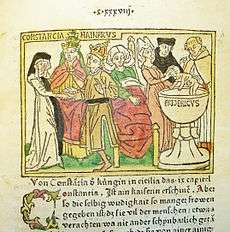
The accession of Frederick, a child who would then become also the Holy Roman Emperor Frederick II in 1197, greatly affected the immediate future of Sicily. For a land so used to centralised royal authority, the king's young age caused a serious power vacuum. His uncle Philip of Swabia moved to secure Frederick's inheritance by appointing Markward von Anweiler, margrave of Ancona, regent in 1198. Meanwhile, Pope Innocent III had reasserted papal authority in Sicily, but recognised Frederick's rights. The pope was to see papal power decrease steadily over the next decade and was unsure about which side to back at many junctures.[11]
The Hohenstaufen's grip on power, however, was not secure. Walter III of Brienne had married the daughter of Tancred of Sicily. She was sister and heiress of the deposed King William III of Sicily. In 1201 William decided to claim the kingdom. In 1202, an army led by the chancellor Walter of Palearia and Dipold of Vohburg was defeated by Walter III of Brienne. Markward was killed, and Frederick fell under the control of William of Capparone, an ally of the Pisans. Dipold continued the war against Walter on the mainland until the claimant's death in 1205. Dipold finally wrested Frederick from Capparone in 1206 and gave him over to the guardianship of the chancellor, Walter of Palearia. Walter and Dipold then had a falling out, and the latter captured the royal palace, where he was besieged and captured by Walter in 1207. After a decade, the wars over the regency and the throne itself had ceased.[9]
The reform of the laws began with the Assizes of Ariano in 1140 by Roger II. Frederick continued the reformation with the Assizes of Capua (1220) and the promulgation of the Constitutions of Melfi (1231, also known as Liber Augustalis), a collection of laws for his realm that was remarkable for its time.[11] The Constitutions of Melfi were created in order to establish a centralized state. For example, citizens were not allowed to carry weapons or wear armour in public unless they were under royal command.[11] As a result, rebellions were reduced. The Constitutions made the Kingdom of Sicily an absolute monarchy, the first centralized state in Europe to emerge from feudalism; it also set a precedent for the primacy of written law.[10] With relatively small modifications, the Liber Augustalis remained the basis of Sicilian law until 1819.[12] During this period, he also built the Castel del Monte, and in 1224, he founded the University of Naples, now called Università Federico II.[13] It remained the sole athenaeum of southern Italy for centuries.
After the death of Frederick, the Kingdom was ruled by Henry VII of Germany and Conrad IV of Germany. The next legitimate heir was Conrad II, who was too young at the period to rule. Manfred of Sicily, the illegitimate son of Frederick, took the power and ruled the kingdom for fifteen years while other Hohenstaufen heirs were ruling various areas in Germany.[11] After long wars against the Papal States, the Kingdom managed to defend its possessions, but the Papacy declared the Kingdom escheated because of disloyalty of the Hohenstaufen.[14] Under this pretext he came to an agreement with Louis IX, King of France. Louis's brother, Charles of Anjou, would become king of Sicily. In exchange, Charles recognized the overlordship of the Pope in the Kingdom, paid a portion of the papal debt, and agreed to pay annual tribute to the Papal States.[14][15] The Hohenstaufen rule in Sicily ended after the 1266 Angevin invasion and the death of Conradin, the last male heir of Hohenstaufen, in 1268.[15]
Angevin Sicily

In 1266, conflict between the Hohenstaufen house and the Papacy led to Sicily's conquest by Charles I, Duke of Anjou. With the usurpation of the Sicilian throne from Conradin by Manfred of Sicily in 1258, the relationship between the Papacy and the Hohenstaufen had changed again. Instead of the boy Conradin, safely sequestered across the Alps, the Papacy now faced an able military leader who had greatly supported the Ghibelline cause at the battle of Montaperti in 1260. Accordingly, when negotiations broke down with Manfred in 1262, Pope Urban IV again took up the scheme of disseising the Hohenstaufen from the kingdom, and offered the crown to Charles of Anjou again. With Papal and Guelph support Charles descended into Italy and defeated Manfred at the battle of Benevento in 1266 and in 1268 Conradin at the battle of Taglicozzo.
Opposition to French officialdom and taxation combined with incitement of rebellion by agents from the Crown of Aragon and the Byzantine Empire led to the successful insurrection of the Sicilian Vespers followed by the invitation and intervention by king Peter III of Aragon in 1282. The resulting War of the Sicilian Vespers lasted until the Peace of Caltabellotta in 1302, dividing the old Kingdom of Sicily in two. The island of Sicily, called the "Kingdom of Sicily beyond the Lighthouse" or the Kingdom of Trinacria, went to Frederick III of the house of Aragon, who had been ruling it. The peninsular territories (the Mezzogiorno), contemporaneously called Kingdom of Sicily but called Kingdom of Naples by modern scholarship, went to Charles II of the house of Anjou, who had likewise been ruling it. Thus, the peace was formal recognition of an uneasy status quo.[15] The division in the kingdom became permanent in 1372, with the Treaty of Villeneuve. Though the king of Spain was able to seize both crowns in the 16th century, the administrations of the two halves of the Kingdom of Sicily remained separated until 1816, when they were reunited in the Kingdom of Two Sicilies.
The insular kingdom of Sicily under the Crown of Aragon and Spain

Sicily was ruled as an independent kingdom by relatives or cadet branch of the house of Aragon until 1409 and thence as part of the Crown of Aragon. The Kingdom of Naples was ruled by the Angevin ruler René of Anjou until the two thrones were reunited by Alfonso V of Aragon, after the successful siege of Naples and the defeat of René on June 6, 1443.[16] Eventually, Alfonso of Aragon divided the two kingdoms during his rule. He gave the rule of Naples to his illegitimate son Ferdinand I of Naples, who ruled from 1458 to 1494, and the rest of the Crown of Aragon and Sicily to Alfonso's brother John II of Aragon. From 1494 to 1503 successive kings of France Charles VIII and Louis XII, who were heirs of Angevins, tried to conquer Naples (see Italian Wars) but failed. Eventually the Kingdom of Naples was reunited with the Crown of Aragon. The titles were held by the Aragonese kings of the Crown of Aragon until the end of the Spanish branch of the House of Habsburg in 1700.
Malta under the Knights

In 1530, in an effort to protect Rome from Ottoman invasion from the south, Charles V, Holy Roman Emperor, as Charles I of Spain, gave the Islands of Malta and Gozo to the Knights Hospitaller in perpetual fiefdom, in exchange for an annual fee of two Maltese falcons, which they were to send on All Souls' Day to the Viceroy of Sicily.[17] The Maltese Islands had formed part of the County, and later the Kingdom of Sicily, since 1091. The feudal relationship between Malta and the Kingdom of Sicily was continued throughout the rule of the Knights, until the French occupation of Malta in 1798.[17]
The occupation was not recognized, and Malta was de jure part of the Kingdom of Sicily from 1798 to 1814. After the Maltese rebellion against the French, Malta was under British protection until it became a British crown colony in 1813. This was officially recognized by the Treaty of Paris of 1814, which marked the end of Malta's 700-year relationship with Sicily.
The War of the Spanish Succession
From 1713 until 1720 the Kingdom of Sicily was ruled briefly by the House of Savoy, which had received it by the terms of the Treaty of Utrecht, which brought an end to the War of the Spanish Succession. The kingdom was a reward to the Savoyards, who were thus elevated to royal rank. The new king, Victor Amadeus II, travelled to Sicily in 1713 and remained a year before returning to his mainland capital, Turin, where his son the Prince of Piedmont had been acting as regent. In Spain the results of the war had not been truly accepted, and the War of the Quadruple Alliance was the result. Sicily was occupied by Spain in 1718. When it became evident that Savoy had not the strength to defend as remote a country as Sicily, Austria stepped in and exchanged its Kingdom of Sardinia for Sicily. Victor Amadeus protested this exchange, Sicily being a rich country of over one million inhabitants and Sardinia a poor country of a few hundred thousand, but he was unable to resist his "allies". Spain was finally defeated in 1720, and the Treaty of the Hague ratified the changeover. Sicily belonged to the Austrian Habsburgs, who already ruled Naples.[18] Victor Amadeus, for his part, continued to protest for three years, and only in 1723 decided to recognize the exchange and desist from using the Sicilian royal title and its subsidiary titles (such as King of Cyprus and Jerusalem).
The Tunisian-Sicilian War
The Tunisian-Sicilian War occurred between June 1801 and April 1804, when Tunisian pirates with Tunisian and Algerian military support attacked and captured several Sicilian ships.[19] The main purpose of their attacks was to capture Christian-European slaves for the Muslim-Arab slave market in North Africa.[20] The Sicilians defeated the forces of Tunis and then occupied Bizerte and La Goulette until 1808.[21]
The two kingdoms under the house of Bourbon of Spain
In 1735, Naples and Sicily were reconquered by King Philip V of Spain, a Bourbon, who installed his younger son, Duke Charles of Parma, as King Charles VII of Naples and Sicily, starting a cadet branch of the house of Bourbon. In 1799 Napoleon conquered Naples, governed by Ferdinand IV of Naples (later Ferdinand I of the Two Sicilies) at the time. It was formed into the Parthenopaean Republic with French support. Under British pressure, especially from Lord William Bentinck, who was commander of British troops in Sicily, Naples was then handed back to Ferdinand, being forced to create a constitution for the Kingdom of Sicily.[18] The island was under British occupation from 1806-14.[22]
A two-chamber parliament in Palermo and in Naples was formed. The formation of the parliament brought the end of feudalism in the Kingdom. After the defeat of Napoleon in 1815 Ferdinand repealed all reforms. The people of Sicily rebelled but were defeated by Spanish and Austrian forces. In 1848 another Sicilian revolution of independence occurred, which was put down by Ferdinand II of the Two Sicilies, who was nicknamed Rè Bomba after his 5-day bombardment of Messina.[18] From 1816 to 1861 the kingdoms were united under the name Kingdom of the Two Sicilies.[18]
Unification with the Kingdom of Italy
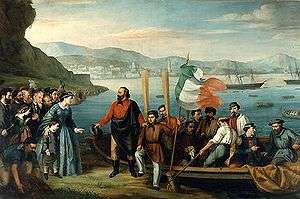
On April 4, 1860 a revolt against the Bourbon regime broke out. Giuseppe Garibaldi assisted the revolt with his forces, launching the so-called Expedition of the Thousand. He arrived at Marsala on May 11, 1860 with 1,000 Redshirts. Garibaldi announced that he was assuming dictatorship over Sicily in the name of King Victor Emmanuel II of Sardinia. On May 15, the Redshirts fought the Battle of Calatafimi and within weeks Palermo was freed. Francis II of the Two Sicilies tried to regain control of the Kingdom. On June 25, 1860 he restored the constitution of the Kingdom, adopted the Italian tricolour as the national flag, and promised special institutions for the Kingdom.[23]
On October 21, 1860 a plebiscite regarding the unification with Italy was conducted. The outcome of the referendum was 432,053 (99%) in favour and only 667 in opposition to unification. With three separate armies still fighting within the Kingdom, this outcome was far from an accurate depiction of public opinion. Substantial inconsistencies as well as the absence of secret ballot further complicates the referendum, which Dennis Mack Smith describes as "obviously rigged".[24][25][26][27][28][29][30] Most Sicilians viewed the unification as acceptance of the House of Savoy, in which belonged Victor Emmanuel II, the first king of Italy.[18]
Society
During the Norman Kingdom of Sicily, the local communities maintained their privileges. The rulers of the Hohenstaufen Kingdom replaced the local nobility with lords from northern Italy, leading to clashes and rebellions against the new nobility in many cities and rural communities. These revolts resulted in the destruction of many agrarian areas and the rise of middle class nationalism, which eventually led to urban dwellers becoming allies of the Aragonese.[11] This situation was continued during the short rule of the Angevin until their overthrowing during the Sicilian Vespers. The Angevin began feudalising the country, increasing the power of the nobility by granting them jurisdiction over high justice.[31] During the 15th century due to the isolation of the Kingdom, the Renaissance had no impact on it.
At the same period the feudalisation of the Kingdom of Sicily was intensified, through the enforcement of feudal bonds and relations among its subjects. In 1669 the eruption of Mount Etna destroyed Catania. In 1693, 5% of the Kingdom's population was killed because of earthquakes. In that period there were also plague outbreaks. The 17th and 18th century were an era of decline of the Kingdom. Corruption was prevalent among the upper and middle classes of the society. Widespread corruption and maltreatment of the lower classes by the feudal lords led to the creation of groups of brigands, attacking the nobility and destroying their fiefs.[18] These groups which were self-named "Mafia", were the foundation of the modern Mafia. The escalation of revolts against the monarchy eventually led to the unification with Italy.[32]
Demographics
During the reign of Frederick II the kingdom had a population of about 2.5 million.[33] During the Hohenstaufen era, the Kingdom had 3 towns with a population of over 20,000 each.[34] After the loss of the northern provinces in 1282 during the Sicilian Vespers and several natural disasters like the eruption of Mount Etna in 1669, the population of the Kingdom of Sicily was reduced.[18] In 1803 the population of the Kingdom was 1,656,000.[35] The main cities of the Kingdom at that period were Palermo, Catania, Messina, Modica, Syracuse.[35]
| Division | Population |
|---|---|
| Val di Mazzara | 643,000 |
| Val di Demona | 521,000 |
| Val di Noto | 459,000 |
| Lipari Islands | 18,000 |
| Aegadian Islands | 12,000 |
| Pantelleria Island | 3,000 |
| Total Population | 1,656,000 |
| City | Population |
|---|---|
| Palermo | 120,000 |
| Catania | 40,000 |
| Messina | 36,000 |
| Modica | 23,500 |
| Syracuse | 17,000 |
Economy
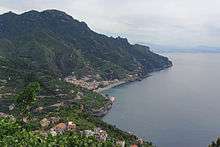
The high fertility of the land led the Norman kings to bring settlers from neighbouring regions or to resettle farmers to areas where cultivation of land was needed. This led to increase of agrarian production. The main sources of wealth for the Kingdom of Sicily at that period were its maritime cities, most important of which were Naples and Amalfi, from which local products were exported. The main export was hard grain, with other products exported including nuts, timber, oil, bacon, cheese, skins, hides, hemp and cloth.[9] Grain and other dry products were measured in salme, which was equivalent to 275.08 litres in the western part of the Kingdom, and 3.3 litres in the eastern part. The salma was divided in 16 tumoli. One tumolo was equivalent to 17,193 litres. Weight was measured in cantari. One cantaro was equivalent to 79.35 kilograms (174.9 lb) and was divided in one hundred rottoli. Cloth was measured in canne. One canna was 2.06 meters long.[5] By the end of the 12th century Messina had become one of the leading commercial cities of the kingdom.
Under the Kingdom, Sicily's products went to many different lands. Among these were Genoa, Pisa, the Byzantine Empire, and Egypt. Over the course of the 12th century, Sicily became an important source of raw materials for north Italian cities such as Genoa. As the centuries went on, however, this economic relationship became less advantageous to Sicily, and some modern scholars see the relationship as frankly exploitative.[36] Furthermore, many scholars believe that Sicily went into decline in the late Middle Ages, though they are not agreed on when this decline occurred. Clifford Backman argues that it is a mistake to see the economic history of Sicily in terms of victimization, and contends that the decline really began in the second part of the reign of Frederick III, in contrast to earlier scholars who believed that Sicilian decline had set in earlier.[37] Where earlier scholars saw late medieval Sicily in continuous decline, Stephen Epstein argued that Sicilian society experienced something of a revival in the 15th century.[38]
Various treaties with Genoa secured and strengthened the commercial power of Sicily.[9]
The feudalising of the society during the Angevin rule reduced royal wealth and treasury. The dependence of the Angevin on north Italian commerce and financing by Florentine bankers were the main factors which led to the decline of the Kingdom's economy.[31] The continuation of the economic decline combined with the increased population and urbanization led to decrease of agrarian production.
In 1800 one-third of the available crops was cultivated, with obsolete cultivation methods escalating the problem. In the later period of Spanish rule the trading system was also inefficient in comparison with previous periods because of high taxes on exports and monopolising corporations which had total control of prices.[39]
Coinage
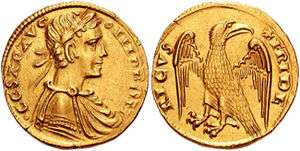
The Norman kings in the 12th century used the tari, which had been used in Sicily from 913 as the basic coin. One tari weighed about one gram and was 16 1⁄3 carats of gold. The Arab dinar was worth four tari, and the Byzantine solidus six tari.[9] In the kingdom one onza was equivalent to thirty tari or five florins. One tari was worth twenty grani. One grana was equivalent to six denari. After 1140 the circulation of the copper coin romesina stopped and it was replaced by the follaris. Twenty four follari were equivalent to one Byzantine miliaresion.
After defeating the Tunisians in 1231 Frederick II, Holy Roman Emperor minted the augustalis. It was minted in 21 1⁄2 carats and weighed 5.28 grams.[40] In 1490 the triumphi were minted in Sicily. They were equivalent to the Venetian ducat. One triumpho was worth 11 1⁄2 aquilae. One aquila was worth twenty grani. In transactions tari and pichuli were mainly used.[5]
Religion
During the Norman reign, several different religious communities coexisted in the Kingdom of Sicily. They were: Latin Christians (Roman Catholics), Greek-speaking Christians (Eastern Orthodox), Muslims and Jews. Although local religious practices were not interrupted, the fact that Latin Christians were in power tended to favor Latin Christianity (Roman Catholicism). Bishops of the Eastern Orthodox rite were obliged to recognize the claims of the Latin Church in Sicily, while Muslim communities were no longer ruled by local emirs. Greek-speaking Christians, Latin Christians, and Muslims interacted on a regular basis, and were involved in each other's lives, economically, linguistically, and culturally. Some intermarried. Christians living in an Arabic-speaking area might adopt Arabic or even Muslim names.[41] In many cities, each religious community had its own administrative and judicial order. In Palermo, Muslims were allowed to publicly call for prayer in mosques, and their legal issues were settled by qadis, judges who ruled in accordance with Islamic law.[9]
After the establishment of Hohenstaufen authority Latin- and Greek-speaking Christians maintained their privileges, but the Muslim population was increasingly oppressed. The settlements of Italians brought from northern Italy (who wanted Muslim property for their own) led many Muslim communities to revolt or resettle in mountainous areas of Sicily.[42] These revolts resulted in some acts of violence, and the eventual deportation of Muslims, which began under Frederick II. Eventually, the government removed the entire Muslim population to Lucera in Apulia and Girifalco in Calabria, where they paid taxes and served as agricultural laborers, craftsmen, and crossbowmen for the benefit of the king. The colony at Lucera was finally disbanded in 1300 under Charles II of Naples, and many of its inhabitants sold into slavery.[42] The Jewish community was expelled after the establishment of the Spanish Inquisition from 1493 to 1513 in Sicily. The remaining Jews were gradually assimilated, and most of them converted to Roman Catholicism.[5]
See also
- Angelo da Furci
- Arab-Norman culture
- County palatine of Cephalonia and Zakynthos
- Emirate of Sicily
- Expedition of the Thousand
- Expulsion of the Jews from Sicily
- Kingdom of Naples
- Kingdom of the Two Sicilies
- List of Sicilian monarchs
- Norman conquest of southern Italy
- Redshirts
- Sicilian Parliament
- Tunisian-Sicilian War
- War of the Sicilian Vespers
References
- ↑ Documenti per servire alla storia di Sicilia: Diplomatica (in Italian). U. Manfredi Editori. 1891-01-01.
- ↑ Vio, Michele Del (1706-01-01). Felicis, et fidelissimæ urbis Panormitanæ selecta aliquot ad civitatis decus, et commodum spectantia privilegia per instrumenta varia Siciliæ ... opera don Michaelis De Vio .. (in Italian). in palatio senatorio per Dominicum Cortese.
- ↑ Gregorio, Rosario (1833-01-01). Considerazioni sopra la storia di Sicilia dai tempi normanni sino al presenti (in Italian). dalla Reale Stamperia.
- ↑ Mongitore, Antonino; Mongitore, Francesco Serio e (1749-01-01). Parlamenti generali del regno di Sicilia dall' anno 1446 sino al 1748: con le memorie istoriche dell' antico, e moderno uso del parlamento appresso varie nazioni, ed in particolare della sua origine in Sicilia, e del modo di celebrarsi (in Italian). Presso P. Bentivenga.
- 1 2 3 4 N. Zeldes (2003). The former Jews of this kingdom: Sicilian converts after the Expulsion, 1492–1516. BRILL. pp. 5, 69, 296–97. ISBN 90-04-12898-0.
- ↑ "Chronological - Historical Table Of Sicily". In Italy Magazine. 7 October 2007.
- ↑ Douglas, David. The Norman Fate, 1100-1154. Los Angeles: University of California Press, 1976.
- 1 2 3 4 Houben, Hubert (2002). Roger II of Sicily: A Ruler between East and West. Cambridge University Press. pp. 7, 148. ISBN 0-521-65573-0.
- 1 2 3 4 5 6 7 8 Donald Matthew (1992). The Norman kingdom of Sicily. Cambridge University Press. pp. 4–6, 71–74, 86–92, 285, 286, 304,. ISBN 0-521-26911-3.
- 1 2 3 4 Malcolm Barber (2004). The two cities: medieval Europe, 1050–1320. Routledge. p. 211. ISBN 0-415-17414-7.
- 1 2 3 4 5 David Nicolle (2002). Italian medieval armies 1000–1300. Osprey Publishing. pp. 5–10, 18–19, 34. ISBN 1-84176-322-5.
- ↑ James Ross Sweeney, Stanley Chodorow (1989). Popes, teachers, and canon law in the Middle Ages. Cornell University Press. ISBN 0-8014-2264-7.
- ↑ Hunt Janin (2008). The University in Medieval Life, 1179–1499. McFarland. p. 132. ISBN 0-7864-3462-7.
- 1 2 Katherine Fisher (2004). Magna Carta. Greenwood Publishing Group. pp. 53, 84–85. ISBN 0-313-32590-1.
- 1 2 3 Steve Runciman (1958). The Sicilian Vespers: a history of the Mediterranean world in the later thirteenth century. Cambridge University Press. pp. 32–34, 209, 274. ISBN 0-521-43774-1.
- ↑ Allan W. Atlas (1985). Music at the Aragonese court of Naples. Cambridge University Press. p. 1. ISBN 0-521-24828-0.
- 1 2 Carolyn Bain (2004). Malta & Gozo. Lonely Planet. p. 23. ISBN 1-74059-178-X.
- 1 2 3 4 5 6 7 Danforth Prince (2007). Frommer's Sicily. Frommer's. p. 314. ISBN 0-470-10056-7.
- ↑ http://daddezio.com/italy/barbary/history.html
- ↑ Davis, Robert. Christian Slaves, Muslim Masters: White Slavery in the Mediterranean, the Barbary Coast and Italy, 1500–1800.
- ↑ Lambert, Frank. The Barbary Wars. New York: Hill and Wang, 2005.
- ↑ W. H. Clements, "The Defences of Sicily, 1806-1815," Journal of the Society for Army Historical Research, Autumn 2009, Vol. 87 Issue 351, pp 256-272
- ↑ Alfonso Scirocco (2007). Garibaldi: citizen of the world. Princeton University Press. p. 279. ISBN 0-691-11540-0.
- ↑ Smith, Denis Mack (1992-03-01). Italy and Its Monarchy. Yale University Press. p. 17. ISBN 0300051328.
- ↑ Smith, Denis Mack (1985-04-18). Cavour and Garibaldi 1860: A Study in Political Conflict. Cambridge University Press. p. 389. ISBN 9780521316378.
- ↑ Finkelstein, Monte S. (1998-01-01). Separatism, the Allies and the Mafia: The Struggle for Sicilian Independence, 1943-1948. Lehigh University Press. p. 14. ISBN 9780934223515.
- ↑ Hess, Henner (1998-01-01). Mafia & Mafiosi: Origin, Power and Myth. NYU Press. p. 155. ISBN 9781863331432.
- ↑ Lukacs, John (1968-01-01). Historical Consciousness: The Remembered Past. Transaction Publishers. p. 116. ISBN 9781412825146.
- ↑ Ziblatt, Daniel (2006-01-01). Structuring the State: The Formation of Italy and Germany and the Puzzle of Federalism. Princeton University Press. p. 102. ISBN 0691121672.
- ↑ Noble, Thomas F. X. (1994). Western civilization. Houghton Mifflin. p. 895.
- 1 2 Samantha Kelly (2003). The new Solomon: Robert of Naples (1309–1343) and fourteenth-century kingship. BRILL. p. 134. ISBN 90-04-12945-6.
- ↑ Lucy Riall (1998). Sicily and the unification of Italy: liberal policy and local power, 1859–1866. Oxford University Press. p. 206. ISBN 0-19-820680-1.
- ↑ Kenneth M. Setton (1985). A History of the Crusades, Volume V: The Impact of the Crusades on the Near East. University of Wisconsin Press. p. 313. ISBN 0-299-09144-9.
- ↑ Perry Anderson (1984). Lineages of the Absolutist State. Verso. p. 146. ISBN 0-86091-710-X.
- 1 2 3 4 Jedidiah Morse. A compendious and complete system of modern geography: or, A view of the present state of the world. Thomas and Andrews. p. 503.
- ↑ Henri Bresc (in Un monde mediteranéen) claims that Sicily was reduced to an agricultural hinterland for wealthier northern Italian cities, and sees the Sicilian people as an early proletariat
- ↑ Backman, The Decline and Fall of Medieval Sicily, 1995.
- ↑ Epstein, An Island for Itself: Economic Development and Social Change in Late Medieval Sicily, (2003).
- ↑ Desmond Gregory (1988). Sicily: the insecure base: a history of the British occupation of Sicily, 1806–1815. Fairleigh Dickinson Univ Press. p. 35. ISBN 0-8386-3306-4.
- ↑ Peter L. Bernstein (2000). The power of gold: the history of an obsession. John Wiley and Sons. p. 90. ISBN 0-471-25210-7.
- ↑ Metcalfe, Alex. Muslims and Christians in Norman Sicily. Arabic Speakers and the End of Islam, (2003).
- 1 2 The best discussion of the fate of Sicilian Muslims can be found in Julie Taylor, Muslims in Medieval Italy: The Colony at Lucera (2003), but is also discussed in Alex Metcalfe, The Muslims of Medieval Italy (2009).
Sources
- Abulafia, David. Frederick II: A Medieval Emperor, 1988.
- Abulafia, David. The Two Italies: Economic Relations between the Kingdom of Sicily and the Northern Communes, Cambridge University Press, 1977.
- Abulafia, David. The Western Mediterranean Kingdoms 1200–1500: The Struggle for Dominion, Longman, 1997. (a political history)
- Johns, Jeremy. Arabic administration in Norman Sicily : the royal dīwān, Cambridge University Press, 2002.
- Mendola, Louis; Alio, Jacqueline. The Peoples of Sicily: A Multicultural Legacy, Trinacria Editions, New York, 2013.
- Mendola, Louis. The Kingdom of Sicily 1130-1860, Trinacria Editions, New York, 2015.
- Metcalfe, Alex. Muslims and Christians in Norman Sicily: Arabic Speakers and the End of Islam, Routledge, 2002.
- Metcalfe, Alex. The Muslims of Medieval Italy, 2009.
- Norwich, John Julius. Sicily: An Island at the Crossroads of History, 2015.
- Runciman, Steven. The Sicilian Vespers: A History of the Mediterranean World in the Late 13th Century, Cambridge University Press, 1958.
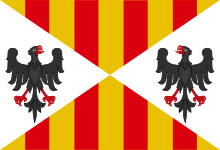



.svg.png)
